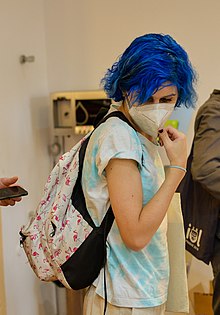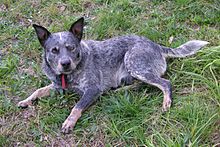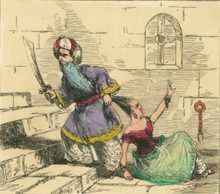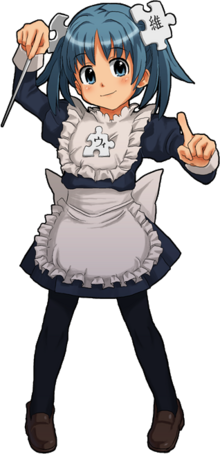Blue hair



Blue hair does not naturally occur in human hair pigmentation,[1] although the hair of some animals (such as dog coats) is described as blue.
Some people (typically of East Asian descent) are born with black hair that is so dark that it appears to have a metallic blue luster. In Japan, the beauty ideal for a woman is to have glossy "blue-black" hair,[2] and Western foreign observers have also held this quality in high regard.[3]
Fashion
The 18th-century English politician Charles Fox was a fashionable macaroni in his youth and tinted his hair with blue powder.[4]

In 1913–1914, just before World War I, there was a vogue for dyed brightly-colored hair in different shades such as blue, violet or emerald. This started in Paris and then spread to other cities such as London.[5][6][7] In 1924, the first celebrity hairstylist, Monsieur Antoine (Antoni Cierplikowski), dyed his dog's hair blue. An influential client, Lady Elsie De Wolfe Mendl, took up the same style and this started a new fad.[8] Later in the 20th century, mature ladies had a blue rinse to conceal grey hair. The Queen Mother was the trend-setter and the peak of popularity for this fashion was the period following World War II.[9][10]
In the 2007 fall fashion season, designers such as Marc Jacobs and Duckie Brown dyed the hair of their models blue to give them a shocking punk look.[11] In 2011, the blue rinse became fashionable again and exemplars included Kate Bosworth with a dip-dyed style of turquoise tips while Thakoon Panichgul continued to present models with startling, all-blue hair.[10]
A synthetic dye used to color hair blue was 1,4,5,8-tetraaminoanthraquinone prepared as Disperse Blue 1 with water and lignosulfonate dispersant. This is a semi-permanent dye as the dye molecules do not penetrate the hair shaft and so wash out in subsequent shampooing. It is not used in the U.S. as it is thought to be carcinogenic.[12]
American politics
Beginning in the 2010s, and into the early 2020s, blue hair (and less commonly purple hair) has become associated with environmentalism, feminism, anarchism, communism, socialism, liberalism, abortion and the LGBTQ community, especially the young Generation Z and Millennial members of those socio-political movements.[13][14] In response, supporters of conservatism in the United States and the Republican Party have started to use blue hair as a sign of an individual holding liberal philosophy, and some conservatives consider dyed hair, including blue, to be "danger hair", in that the dyed person's opinions are irrelevant and not worth listening to. First coined by users of 4chan, itself often associated with the alt-right, conservatives in the US began using "blue-haired liberals" as a taunt towards those who have "blue hair and pronouns".[15][16][17]
Occupational causes
The hair of workers who regularly come into close contact with cobalt or indigo may become blue because of the dust of the substance mixing into the hair follicles. The colour in these cases is "not merely superficial."[18]
Other animals
Some varieties of rabbit have been bred with blue hair such as the Belgian breed, the Blue of Sint-Niklaas.[19] This was a light sky blue in color with a white blaze.[19] Other breeds of blue rabbit are darker and there are about 45 different shades or textures recognised by show judges.[19][20]

There are several breeds of dogs which may have a blue coat including the Kerry Blue Terrier, Bluetick Coonhound and Grand Bleu de Gascogne. This arises in two main ways: from a dilution or silvering of a black coat so that it is seen as blue-grey; or from a mottling or marbling effect which mixes black and white to be seen as navy blue.[citation needed]

The fleece of sheep may be a natural blue-grey, such as the Himalayan blue sheep, or may be dyed blue as a raddle or to make them more conspicuous in snowy conditions.[21][22]
Oxen breeds referred to as Blue Roane were plentiful centuries ago (shades of blue) and some of that genetics somehow evolved into slight tinting of blue in some Holstein cattle.
The coat of several other animals is called blue, including those of blue roan horses, the Russian Blue cat, and the blue variant of the Arctic fox's coat.
Artistic representations
Pictures
Blue hair has been described as a "sacred aesthetic" in ancient Egypt and Mesopotamia, where lapis lazuli was used in funerary art and statuary.[23]
Many colored pictorials from the Anglo-Saxon tribes after the departure of Roman troops feature women with blue hair. According to Gale R. Owen-Crocker in Dress in Anglo-Saxon England "the use of colour in Anglo-Saxon art is not realistic ... and there is no need to assume dye was used on the hair."[24]
Representations of the Buddha often feature blue hair, sometimes of a brilliant hue.[25][26] This artistic convention emphasizes the blue element in the 'blue-black' hair said to be one of the 32 special physical characteristics of the Buddha.[26] Traces of ancient blue pigment could be seen in the hair grooves of some of the 4-6C Buddhas known as the 'Qingzhou Buddhas' found in an ancient schoolyard pit in China in Qingzhou (Shandong) in 1996, shown on exhibit in London and many other world capitals.[27]
Literary works
In some works by Homer, characters are said to have dark blue (kyaneos) hair or eyebrows when they are angry or in an emotionally intense state.[28] For example, Odysseus' beard became black blue when he was transformed by Athena upon returning home to confront his wife's suitors.[29] Other Greek gods were also shown as having blue hair.[30] This imagery may stem from Egyptian myth, in which their gods were said to have hair of lapis lazuli.[31][32] In a similar vein, characters from the Bible, such as Eve, Leah, and Rachel, are often depicted with a "sky-blue" color of hair.[33] Color in ancient countries (Greece and Egypt) were also more expressive rather than natural: blue or gold indicated divinity due to its unnatural appearance and association with precious materials.
The Fairy with Turquoise Hair is a major character in Pinocchio. She is often titled as the "Child with the Blue Hair" and even has a chapter in The Adventures of Pinocchio devoted to this title.[34] Literary critics have offered varied interpretations of her hair color. It may invoke associations with "the ineffable or infinite", with the Italian sky, or with the Virgin Mary, who is often shown with a blue mantle.[35]
The sci-fi/fantasy anthology, Once Upon a Future Time Volume 4, includes a short story, "The Blue Fairy," in which a woman with blue hair is accused of illegally creating androids.

The color blue owned aristocratic associations in Europe during the second millennium, and this linkage with blue blood was reflected in Charles Perrault's story of Bluebeard.[36] In Maria Tatar's view, the color of his beard suggests otherworldly origins.[37]
In pop culture
Music
Musicians Loredana Bertè, Ashnikko, Katy Perry, Lady Gaga, Halsey, and Alissa White-Gluz have dyed their hair blue alongside female rappers such as Latto.[citation needed]
Other visual media
The cartoon character Marge Simpson is depicted as having blue hair, as are a number of other characters from the show like Chief Wiggum and Milhouse.
Ed, Edd n Eddy has two of their visible set of characters being blue-haired: Marie Kanker and Rolf.
2-D, the fictional singer of the British virtual band, Gorillaz has natural blue hair caused by a head injury after he fell out of a tree as a child.
Jok Church's character, Beakman, also has blue hair, which is a throwback reference, according to the creator, to an older version of Superman, who also had a blue tint to his hair.[38] A similar case of bluish black hair can also be seen in Batman (Bruce Wayne) in his older comics. This “blue tint technique“ was very common to avoid any black hair to appear grizzled.[citation needed]

In anime and manga, it’s common to have characters with colored hair. Anime characters who have blue hair include Bulma of the popular Dragon Ball series, Mana Takamiya of the Date A Live series, Sailor Mercury of the Sailor Moon series and Rei Ayanami of the Neon Genesis Evangelion. One author, in writing of Rei, sees her hair color as a marker of both her 'unearthliness' and her introversion.[39] Strong Bad, from the animated webseries Homestar Runner, lampshades this trend by stating emphatically that in order to be a proper anime character, "You gotta have blue hair!"[40][41]
The 2010 graphic novel Blue Is the Warmest Color and its 2013 film adaptation features a lesbian relationship between a teenage girl and an art student with blue hair.
See also
References
- ^ Rod Fairweather (1998), Basic studio directing, Focal Press, ISBN 978-0-240-51525-0
- ^ Minor, W. (2004). Jazz Journeys to Japan: The Heart Within. Jazz Perspectives Series. University of Michigan Press. p. 164. ISBN 978-0-472-11345-3. Retrieved 2024-04-03.
- ^ Lawson, K. (1910). Highways and Homes of Japan. T. Fisher Unwin. p. 150-IA3. Retrieved 2024-04-03. "Japanese woman's hair is invariably glossy black, with a beautiful blue - black metallic lustre about it, and as it is kept soft with much washing and ointments, it makes up well."
- ^ William Edward Mead (1970), The Grand Tour in the Eighteenth Century, Boston and New York, Houghton Mifflin Company
- ^ "Emerald Coiffure New London Style", The New York Times, 28 December 1913
- ^ Emile Long (1999), "January 1914: Blue, Green, Red and Violet Hair in Demand in Paris", Hairstyles and fashion: a hairdresser's history of Paris, 1910-1920, Berg Publishers, ISBN 978-1-85973-222-9
- ^ "Coloured Hair: A New Fashion From Paris", The Sydney Mail, May 20, 1914,
Some hair is of a strange blue tint, unreal ...
- ^ Victoria Sherrow (2006), Encyclopedia of hair, Bloomsbury Academic, pp. 164–5, ISBN 978-0-313-33145-9
- ^ David Derbyshire (April 21, 2006). "End of the blue rinse". The Daily Telegraph.
The blue rinse hairstyle became popular in Britain in the 1930s, but grew to its peak after the war. The rinse was a dilute hair dye designed to reduce the appearance of greying hair. ...
- ^ a b Alicia Waite (26 October 2011), "Welcome to the new blue-rinse brigade", The Daily Telegraph
- ^ "Designers Punk Out With Blue Hair, Eyes", New York, 2007
- ^ Barry Leonard (1999-11-01), "Disperse Blue 1", Eighth Annual Report on Carcinogens: 1998 Summary, DIANE, ISBN 978-0-7881-8396-6
- ^ Ellis, Emma Grey (2020-11-03). "My Life as a Blue-Haired 'Commie Bitch' in Portland". Wired. ISSN 1059-1028. Retrieved 2023-03-16.
- ^ "4 Reasons Why Gay People Might Dye Their Hair". Sdlgbtn. 20 October 2022. Retrieved 2023-03-16.
- ^ "The bottomless self-pity of American conservatives". The Week. 24 November 2021. Retrieved 2023-05-08.
- ^ "Blue Hair Is a Liberal Trait, According to Triggered Republicans". MEL Magazine. 2022-05-12. Retrieved 2023-05-08.
- ^ "Every Insult the Right Uses to Troll Liberals, Explained". www.vice.com. 6 February 2017. Retrieved 2023-05-08.
- ^ Hermann Beigel (1869), The human hair: its structure, growth, diseases, and their treatment
- ^ a b c Meg Brown; Virginia Richardson (2000), Rabbitlopaedia: A Complete Guide to Rabbit Care, Interpet, ISBN 978-1-86054-182-7
- ^ Barry Martin (1990), Rabbits as a new pet, T.F.H. Publications, p. 42, ISBN 978-0-86622-618-9
- ^ Fighting leaves male sheep blue, BBC, 24 September 2008
- ^ "Dyed blue sheep graze in the hills of County Antrim", The Daily Telegraph, December 2010
- ^ David Wengrow (2010), What Makes Civilization?: The Ancient Near East and the Future of the West, Oxford University Press, p. 34, ISBN 978-0-19-280580-5
- ^ Owen-Crocker, Gale R. (July 1990), Dress in Anglo Saxon England, Manchester Univ Press, p. 169, ISBN 0-7190-3290-3
- ^ Veronica Freeman (2006), The poetization of metaphors in the work of Novalis. Volume 78 of Studies on themes and motifs in literature, Peter Lang, p. 171, ISBN 978-0-8204-7865-4
- ^ a b Patricia Eichenbaum Karetzky (2000), Early Buddhist narrative art: illustrations of the life of the Buddha from Central Asia to China, Korea, and Japan, University Press of America, p. 78, ISBN 978-0-7618-1671-3
- ^ "The Lost Buddhas: Chinese Buddhist Sculpture from Qingzhou | Asian Art". Archived from the original on 2015-06-24. Retrieved 2016-02-09.
- ^ Selina Stewart (2006), "The Blues of Aratus", Beyond the canon, Peeters Publishers, ISBN 978-90-429-1813-9
- ^ Homer (1990), The Odyssey of Homer, translated by Allen Mandelbaum, University of California Press, ISBN 978-0-520-07021-9
- ^ Fenno Hoffman, Charles; Lewis Gaylord Clark; Kinahan Cornwallis; Timothy Flint; John Holmes Agnew; Washington Irving (1834), The Knickerbocker; or, New York monthly magazine, Volume 3, pp. 218–219, retrieved December 10, 2010
- ^ RD Griffith (2005), "Gods' blue hair in Homer and in eighteenth-dynasty Egypt", The Classical Quarterly, 55 (2), Cambridge University Press: 329–334, doi:10.1093/cq/bmi034
- ^ W.H.R. Rivers (1901), "Primitive Color Vision", Popular Science, 59, McClure, Phillips and Co.: 54, retrieved December 11, 2010,
Even in the case of Egyptian art, one reads of statues of human figures with blue hair, and in the case of early Greek art, the inappropriate Use of one color, blue appears to have been very common. ...
- ^ Conant Church, William (1873), The Galaxy, Volume 15, W.C. and F.P. Church, p. 289, retrieved December 10, 2010
- ^ H. Frey, Charles; John W. Griffith (1987), The literary heritage of childhood: an appraisal of children's classics in the Western tradition, Greenwood Press, ISBN 978-0-313-25681-3, retrieved December 12, 2010
- ^ Carlo Collodi; Nicolas J. Perella (2005), The Adventures of Pinocchio/ Le Avventure Di Pinocchio, University of California Press, p. 30, ISBN 978-0-520-24686-7
- ^ Maria Tatar (2004), Secrets beyond the door: the story of Bluebeard and his wives, Princeton University Press, p. 19, ISBN 978-0-691-11707-2
- ^ Maria Tatar (2002), The annotated classic fairy tales, W. W. Norton & Company, p. 145, ISBN 978-0-393-05163-6
- ^ Jok Church (June 30, 2006), "Comics: Meet the Artist", The Washington Post,
It was actually Marge Simpson. But the blue hair is really more of a tribute to Superman than to Marge, as much as I do love Marge. Superman/Clark Kent's hair was always black with a blue sheen to it.
- ^ Dennis Redmond (2004), The world is watching: video as multinational aesthetics, 1968-1995, Southern Illinois University Press, p. 135, ISBN 978-0-8093-2535-1
- ^ Japanese Cartoon
- ^ sbemail 57
